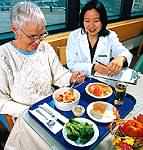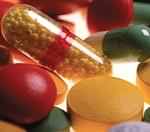|
SCIENCE IN THE NEWS - Vitamins (THEME) VOICE ONE: I'm Bob Doughty with Phoebe Zimmermann, and this is the VOA Special English program SCIENCE IN THE NEWS. VOICE TWO: This week, a special report all about vitamins. We tell about some of the common ones needed for good health.
(THEME) VOICE ONE: Many jobs must be done with two people. One person takes the lead. The other helps. It is this cooperation that brings success. So it is with the human body. Much of our good health depends on the cooperation between substances. When they work together, chemical reactions take place smoothly. Body systems are kept in balance. Some of the most important helpers in the job of good health are the substances we call vitamins. VOICE TWO: The word “vitamin” dates back to Polish scientist Casimir Funk in nineteen-twelve. He was studying a substance in the hull that covers rice. This substance was believed to cure the nervous system disorder beriberi. Funk believed the substance belonged to a group of chemicals known as amines [uh-MEENS]. He added the Latin "vita" meaning life. So he called the substance a “vitamine” [vita-MEEN] -- an amine necessary for life. Funk was not able to separate the anti-berberi substance from the rice hulls; it turned out to be thiamine. And later research showed that not all vitamines were amines after all. So the name was shortened to vitamin. But Funk was correct in recognizing the importance. VOICE ONE: Scientists have discovered fourteen kinds of vitamins. They are known as vitamins A, the B group, C, D, E and K. Scientists say vitamins act like enzymes. They help carry out chemical changes within cells. If we do not get enough of the vitamins we need in our food, we are likely to develop a number of diseases. This brings us back to Polish scientist Casimir Funk and his studies of rice. His experiments were part of a long search for foods that could cure disease. VOICE TWO: One of the first people involved in that search was James Lind of Scotland. In the seventeen-forties, Lind was a doctor for the British Navy. He was trying to solve a problem the Navy had been suffering for hundreds of years. The problem was the disease scurvy. So many British sailors had scurvy that the Navy’s fighting strength was very low. The sailors were weak from continuous bleeding inside their bodies. Their teeth fell out. Even the smallest wound would not heal. Doctor Lind thought the sailors were getting sick because they were unable to eat some kinds of foods when they were at sea for many months. Doctor Lind divided twelve sailors suffering from scurvy into two groups. He gave each group different foods to eat. One group got oranges and lemons. The other did not. The men who ate the fruit began to improve within seven days. The other men got weaker and weaker. Doctor Lind was correct. Eating citrus fruits prevents scurvy. VOICE ONE: Other doctors searched for foods that would cure rickets and pellagra. They did not yet understand that they were seeing the problem backwards. That is, it is better to eat vitamin-rich foods to prevent disease instead of eating them to cure disease after it has developed. Just how do vitamins keep us healthy? Which foods are the best source for different ones? Let us look at some important vitamins for these answers. (MUSIC) VOICE TWO: Vitamin A is needed to produce a light-sensitive substance in the eyes. And it helps prevent skin and other tissues from drying out. People who do not get enough vitamin A cannot see well in the dark. They also may develop a condition that dries the eyes, called xerophthalmia [zir-af-THAL-mea]. It can result in infections and lead to blindness. The best source of vitamin A is fish liver oil. It also is found in the yellow part of eggs. In addition, squash, sweet potatoes, carrots and other darkly colored fruits and vegetables contain substances that the body can change into vitamin A. VOICE ONE: Vitamin B-one is also called thiamine. It changes starchy foods into energy. It also helps the heart and nervous system work smoothly. Without it, we would be weak and would not grow. We also might develop beriberi. Thiamine is found not just in whole grains like brown rice, but also in other foods. These include beans and peas, nuts, and meat and fish. Another B-vitamin is niacin. It helps cells use food energy. It also prevents pellagra, a disease that causes weakness, red skin and stomach problems. Good sources of niacin are meat, fish and green vegetables. Vitamin B-twelve is needed so folic acid can do its work. Together, they help produce red blood cells. Without them, a person suffers from anemia. Vitamin B-twelve is found naturally in foods such as eggs, meat, fish and milk products. Folic acid has been shown to prevent birth defects when taken by women of child-bearing age. It is found in green leafy vegetables and other foods including legumes and citrus fruits. It is also added to enriched breads and other products. The first vitamin discovery in the twenty-first century was made by Japanese researchers in April of two-thousand-three. They identified a new member of the B-vitamin group. It is a substance known since nineteen-seventy-nine: pyrroloquinoline quinone [pi-RO-lo-QUI-no-leen qui-NOHN], or PDQ. The researchers found that it plays an important part in the reproductive and defense systems in mice. They said the substance is similarly important for people. PDQ is found in fermented soybeans and also in parsley, green tea, green peppers and kiwi fruit. VOICE TWO: Vitamin C is necessary for strong bones and teeth, and for healthy blood vessels. It also helps wounds heal quickly. The body stores very little vitamin C. So we must get it every day in foods such as citrus fruits, tomatoes and uncooked cabbage. Vitamin D increases the amount of calcium in the blood. Calcium is needed for nerve and muscle cells to work normally. It also is needed to build strong bones. Vitamin D prevents a children’s bone disease called rickets. Ultraviolet rays from the sun change a form of cholesterol in the skin into vitamin D. Another source is fish liver oil. In some countries, milk producers add vitamin D to milk, especially so children will get enough. Vitamin K is needed for healthy blood. It thickens the blood around a cut to stop bleeding. Bacteria in the intestines normally produce vitamin K. It can also be found in pork and liver and in vegetables like cabbage, kale and spinach. (MUSIC) VOICE ONE: So, how do we know how much of each vitamin we need every day? Public health agencies publish lists of suggested amounts.
But some people take pills each day that contain larger amounts of vitamins. They think the extra vitamins will improve their health and protect against disease. Some doctors agree. But many do not. For one thing, they point out that too much of some vitamins can be harmful to healthy people. For example, too much vitamin A can lead to the bone weakening condition osteoporosis. Too much vitamin B-six can damage the nervous system, causing a loss of feeling in the arms and legs. Too much vitamin E can increase the chances of developing a heart attack or stroke. VOICE TWO: Doctors say only people who know that they lack a vitamin should take extra amounts in pills. Some older people, for example, may not have enough vitamin B-twelve. That is because, as people get older, the body loses its ability to take it from foods. Also, people who do not go outdoors much may need extra vitamin D since the skin makes this vitamin from sunlight. And, women who may become pregnant need to make sure they get enough folic acid to protect the baby from possible birth defects. VOICE ONE: Vitamins are important to our health. But different vitamins are found in different foods -- grains, vegetables and fruits, fish and meat, eggs and milk products. And even foods that contain the same vitamins may have them in different amounts. Nutrition experts say this is why it is important, where possible, to eat a mixture of foods every day, to try to get enough of the vitamins our bodies need. (THEME) SCIENCE IN THE NEWS was written by Nancy Steinbach and produced by Cynthia Kirk. This is Bob Doughty. VOICE TWO: And this is Phoebe Zimmermann. Join us again next week for more news about science in Special English on the Voice of America.
|
| Главная страница |
| Форум сайта |
| Гостевая книга |
| Наши рассылки |
| Написать письмо |
| Теория |
|---|
| Грамматика |
| Произношение |
| Методики изучения |
| Учебные пособия |
| Практика |
|---|
| Чтение |
| Написание |
| Упражнения |
| Идиоматика |
| Тестирование |
| Сленг |
| Программы |
| Помощь |
|---|
| Курсы |
| Репетиторы |

